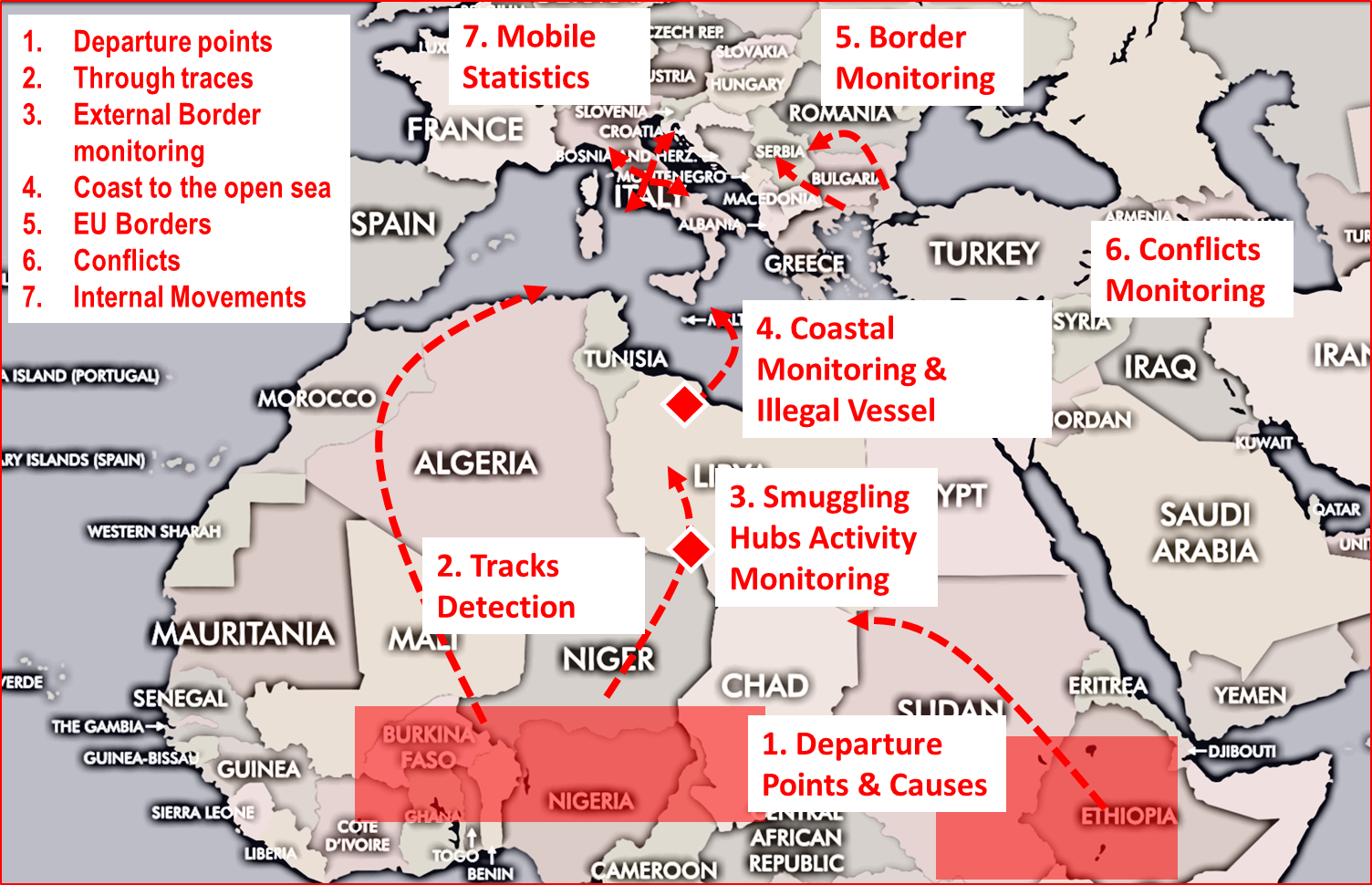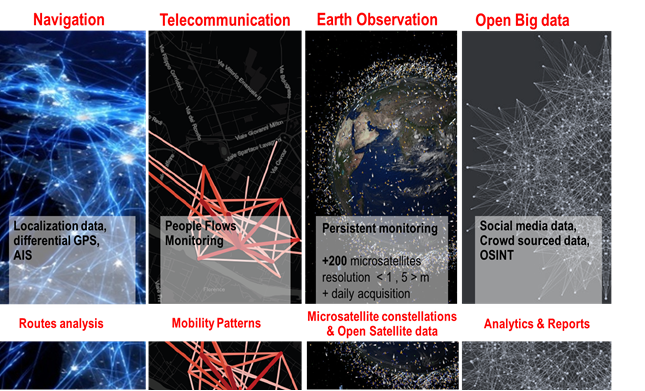
Objectives of the service
The continued instability in several areas in the Middle East, Africa and Asia has resulted in an unprecedented displacement of people at a global level and an increased influx of migrants and refugees in Europe, especially through its South-eastern and Mediterranean borders. In the context of this study the whole complex of migration is considered:
- Mitigation: why do people move? Assessing the root causes of migration, such as families falling apart due to poverty, impact of natural disasters, and – most often – instability caused by conflict.
- Preparedness: early warning & alert concerning migration onsets
- Response: ascertaining human rights, registration and tracking, humanitarian assistance, monitoring hot spots and safe houses, border control, monitoring seas, integration at destination countries
- Repatriation: support sustainable reintegration to avoid renewed mitigation.
In that context, harnessing big data towards strengthened mitigation, preparedness, and response capacities requires:
- Evaluating new procedural approaches to ease the exploitation of traditional and new data and information for supporting event or change detection activities relevant to migration fluxes.
- Developing and tuning advanced analytics features, including but not limited to data mining, machine learning, automatic change detection, for supporting the prioritization of target areas for security surveillance, identify highest probability locations for events of interest, recognize patterns or behaviours and discover hidden relationships.
Users and their needs
The management of the migration crisis is a complex process that requires significant capacities and cooperation/coordination amongst several stakeholders, from different sectors: EU Agencies, National Coordination Centre, humanitarian aid and civil protection actors, NGOs involved on day-to-day management of the migration crisis, national authorities.
Information required from the users are classified in two major areas:
- Activities concerning countries of origin and transit countries
- Activities related for and by destination countries.
The requirements are categorised according to
(a) the location along the migration route, and
(b) the main capacity areas: mitigation, preparedness and response.
In addition to determining their key needs and requirements, the study investigates the actions required to set-up agreements with users / stakeholders for post-project service exploitation and funding.
Service/ system concept
A set of key required services based on the exploitation of big data from space integrated with collateral source of data has been proposed:
- Change detection / trend estimation based on big EO data analysis
- Internal Movement analysis from of mobile phone and social media data
- Situational awareness at hot spots, crossing points, safe houses, camps
- Indices for sudden onset/slow onset events including socio-economic data and monitoring of change.

Space Added Value
The proposed services:
- Provide evidence based indications on how current Earth Observation based services can offer their optimum contribution to user organizations for migration, and more generally civil security and humanitarian aid;
- exploit large set of Sentinel-1 and Sentinel-2 data for the envisaged service chains;
- improve monitoring capabilities using VHR data and data from microsatellite constellations
- analyse the integration of open source and social data (e.g from Twitter, GDELT Project)
- provide anomalies detected from mobile data as input to geospatial based monitoring and searching services
The envisaged End Users benefits are:
- Large-scale multi-temporal conflict monitoring for a more comprehensive situation awareness of decision makers with the aim to support conflict prevention/monitoring or even conflict resolution to mitigate migration
- Analysing the overall situation exploiting big-data multi-temporal sources in the areas of known border hot-spots or safe houses, in order to anticipate and monitor variation in migration flows
- Validate in situ information
Services can be provided:
- Embedding outputs of our service architecture directly within existing platforms of End Users
- Providing a standalone platform feeding ready-made products to interested users (at EU or national level)

Example of Border Monitoring
Current Status
The feasibility study explored big data sources including:
- Mobile phone data
- Social Media data
- Traditional source of data ( administrative sources, border statistics)
- Satellite data (e.g.: SAR, EO, SAT-AIS)
- Intelligence data (e.g.: OSINT and HUMINT)
identifying the legal, technical, ethical and privacy constraints relevant to their application in support to identified use cases.
The interactions with the users (“interview”, “mock-up” presentation) allowed to build a good understanding of their requirements and operational constraints; as result of this process, specific services and business models were proposed.

Services mock-ups were developed and showcased to the users to get their feedback and help fine tune the service offer.
A sustainability analysis was carried out addressing economic and non-economic aspects confirming the viability of the proposed services.
The feasibility study was completed in January 2019: end-user feedbacks encouraged the consortium to work towards a follow-up demo project, to develop and demonstrate the proposed services in a (nearly) operational scenario.




